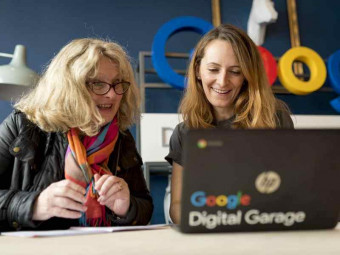Storytelling For Business
Tags: Storytelling
Grab attention. Create emotion. Inspire action.
Last updated 2022-01-10 | 4.5
- You'll learn how to include The 6 Senses in your story scenes to trigger emotional responses.- You'll master The 5 Beats of classic story structure.
- You'll know how to drive your narrative toward one unforgettable selling point.
What you'll learn
* Requirements
*Description
You already know that a well-told story makes the best impression. But how can you master telling compelling stories?
In this workshop, you'll apply a series of practical guidelines, step-by-step, for creating unforgettable stories to use throughout your career.
In both video lectures and workbook exercises, you'll find the nitty-gritty tips and tools of a foolproof workshopping process you can use for crafting story after story.
What You'll Come Away With
After taking this course, you will always know how to bring dry facts and figures to life when you reframe them as human experience. You'll know just what to do when you notice listeners losing interest.
Once and for all, learn how to build an emotionally resonant arc for your brand biographies, your personal anecdotes for professional networking and your vision-into-action stories for presentations.
Be heard, be remembered and create the change you wish to see in your career with dynamic and inspiring storytelling.
Who this course is for:
- Entrepreneurs, Job Seekers, Leaders, Public Speakers, Teachers, Marketers, Advertisers, PR Professionals, Creative Professionals
Course content
5 sections • 17 lectures
What Is A Story? Preview 05:20
In this lecture, we cover the two essential qualities that distinguish a story from any other block of information. In the Supplementary Material for this lecture, we cover even more examples of non-story content transposed into story content. The exercise following this lecture is a guided brainstorm on the most emotional moments of your life.
How Are Stories Told At Work Different From Other Stories? Preview 07:12
In this lecture, we cover the one function that stories told for business need to deliver on, while stories told in other contexts need not. In the Supplementary Material, we take a closer look at a famous story often used in business contexts, and how it makes the most of its Controlling Idea. The exercise following this lecture is a brainstorm on naming specific messages you might want to get across in your work experience in the near future.
How Do You Choose The Right Story For Your Audience? Preview 05:50
In this lecture, we cover the part of the story preparation process that most people make the mistake of skimping on. That is, doing an in-depth analysis of the specific listeners you intend to share your story with ahead of time. In the Supplementary Material, you will do an audience-analysis exercise and you will use an audio recording device to record your first improvised version of at least one of the stories you are workshopping here.
What Is the Difference Between Summary & Scenes? Preview 07:37
In this lecture, we cover one of the most important distinctions to be made while composing stories -- understanding the difference between the two modes in which narrative text functions. We define Narrative Summary and Scenes, and we discuss why knowing the difference between these two modes is so key to grabbing and holding the attention of your listeners. In the Supplementary Material, you will take a quiz to see if you can tell the difference between blocks of text that are Narrative Summary and blocks of texts that are Scenes from famous literature written in the first-person singular point-of-view.
How Do You Include Sights, Sounds, Smells & Tastes in Scenes? Preview 07:17
In this lecture, we cover the first four of The Six Senses, and take a close look at how including details in your story scenes associated with these senses will evoke emotional responses from your listeners. In the Supplemental Material, we delve even deeper, with more examples and an exercise to guide you through the creation of such details for the stories you're currently workshopping.
How Do You Include Thinking Mind Details In Scenes? Preview 04:12
In this lecture, we cover the fifth of The Six Senses, The Thinking Mind. We show how including dialogue spoken out loud, dialogue happening in the mind and musings or fantasies passing through the mind, helps to make a story seem dramatic. In the Supplemental Material, we delve deeper with more examples and stories. We include an exercise that will guide you through the creation of Thinking Mind details for the stories you are currently workshopping.
How Do You Include Feeling Body Details In Scenes? Preview 03:31
In this lecture, we cover the sixth of The Six Senses, The Feeling Body. We show how including details about sensations felt within the body and energy expressed through the body helps to bring emotional life front and center in your story. In the Supplemental Material, we offer more examples and stories. We include an exercise that will guide you through the creation of Feeling Body details for the stories you are currently workshopping.
How Do You Start A Story With A Set-Up & Inciting Incident? Preview 08:01
In this lecture, we begin to explore The Five Beats of a classic story structure, beginning with The Set-Up and The Inciting Incident. We look at examples of these beats working in specific stories. In the Supplemental Material, we look in more depth at other stories and the functions of The Set-Up and Inciting Inciting Incident in those works. And we include an exercise to guide you through the creation of your own Set-Ups and Inciting Incidents for stories you are currently workshopping.
How Do You Create A Middle For Your Story With Rising Action? Preview 03:49
In this lecture, we continue to explore The Five Beats of a classic story structure, now focusing on The Rising Action. We look at examples of this beat and how it works in specific stories. In the Supplemental Material, we look in more depth at other stories and the functions of The Rising Action in those works. And we include an exercise to guide you through the creation of your own Rising Actions for stories you are currently workshopping.
How Do You Create An End For Your Story With A Main Event & Resolution? Preview 04:25
In this lecture, we conclude our exploration of The Five Beats of a classic story structure, focusing on The Main Event and The Resolution. We look at examples of these beats and how they work in specific stories. In the Supplemental Material, we look in more depth at other stories and the functions of The Main Event and The Resolution in those works. And we include an exercise to guide you through the creation of your own Main Events and Resolutions for stories you are currently workshopping.
How Do You Prepare To Share A Story? Preview 05:38
In this lecture, we review the process of story creation as we've explored it so far. We cover tips for shortening, lengthening or polishing a story, as well as tips on using your pitch, rhythm, volume, face, gestures, pauses and more to give your delivery levels of nuance. And finally we offer suggestions on how to keep a story fresh and dynamic in the evolution of your using it over time. In the Supplemental Material, we delve deeper into those tips and more.
How Do You Hone Your Skills In Storytelling? Preview 08:45
In this lecture, I share about my own journey in storytelling. This lecture is a story in itself, and I hope it serves to inspire and instruct on how you too can be taking action to continue to improve as a storyteller in myriad ways. In the Supplemental Material, we review the suggestions from the lecture and more, especially encouraging you to delve deeper into your workshopping efforts with us at TheStoryStudio.org.
Amy's Story Preview 06:08
Story Studio workshop attendee Amy Stephenson shares the story of the most important thing she learned in her first year working as a teacher.
Mattan's Story Preview 09:15
Story Studio workshop attendee Mattan Griffel shares the origin story of his business.
Matt's Story Preview 05:59
Story Studio workshop attendee Matt Lewis shares the story of how he learned to succeed at job interviews.
Sean's Story Preview 05:41
Story Studio workshop attendee Sean Blanda shares the origin story of his business.
Hu's Story Preview 07:28
Story Studio workshop attendee Hu Di shares the story of how she discovered her purpose in her career.








 This course includes:
This course includes:














